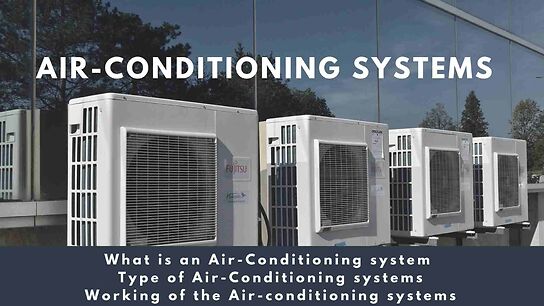An air conditioning, or HVAC&R, system is composed of components and equipment arranged in sequence to condition the air, to transport it to the conditioned space, and to control the indoor environmental parameters of a specific space within required limits. Most air conditioning systems perform the following functions:
1. Provide the cooling and heating energy required
2. Condition the supply air, that is, heat or cool, humidify or dehumidify, clean and purify, and attenuate any objectionable noise produced by the HVAC&R equipment
3. Distribute the conditioned air, containing sufficient outdoor air, to the conditioned space
4. Control and maintain the indoor environmental parameters–such as temperature, humidity, cleanliness, air movement, sound level, and pressure differential between the conditioned space and surroundings—within predetermined limits
Parameters such as the size and the occupancy of the conditioned space, the indoor environmental parameters to be controlled, the quality and the effectiveness of control, and the cost involved determine the various types and arrangements of components used to provide appropriate characteristics.
Air conditioning systems can be classified according to their applications as
(1) comfort air conditioning systems and
(2) process air conditioning systems.
Comfort Air Conditioning Systems
Comfort air conditioning systems provide occupants with a comfortable and healthy indoor environment in which to carry out their activities. The various sectors of the economy using comfort air conditioning systems are as follows:
1. The commercial sector includes office buildings, supermarkets, department stores, shopping centers, restaurants, and others. Many high-rise office buildings, including such structures as the World Trade Center in New York City and the Sears Tower in Chicago, use complicated air conditioning systems to satisfy multiple-tenant requirements. In light commercial buildings, the air conditioning system serves the conditioned space of only a single-zone or comparatively smaller area. For shopping malls and restaurants, air conditioning is necessary to attract customers.
2. The institutional sector includes such applications as schools, colleges, universities, libraries, museums, indoor stadiums, cinemas, theaters, concert halls, and recreation centers. For example, one of the large indoor stadiums, the Superdome in New Orleans, Louisiana, can seat 78,000 people.
3. The residential and lodging sector consists of hotels, motels, apartment houses, and private homes. Many systems serving the lodging industry and apartment houses are operated continuously, on a 24-hour, 7-day-a-week schedule, since they can be occupied at any time.
4. The health care sector encompasses hospitals, nursing homes, and convalescent care facilities. Special air filters are generally used in hospitals to remove bacteria and particulates of submicrometer size from areas such as operating rooms, nurseries, and intensive care units. The relative humidity in a general clinical area is often maintained at a minimum of 30 percent in winter.
5. The transportation sector includes aircraft, automobiles, railroad cars, buses, and cruising ships. Passengers increasingly demand ease and environmental comfort, especially for long distance travel. Modern airplanes flying at high altitudes may require a pressure differential of about 5 psi between the cabin and the outside atmosphere. According to the Commercial Buildings Characteristics (1994), in 1992 in the United States, among 4,806,000 commercial buildings having 67.876 billion ft2 (6.31 billion m2 ) of floor area, 84.0 percent were cooled, and 91.3 percent were heated.
Process Air Conditioning Systems
Process air conditioning systems provide needed indoor environmental control for manufacturing, product storage, or other research and development processes. The following areas are examples of process air conditioning systems:
1. In textile mills, natural fibers and manufactured fibers are hygroscopic. Proper control of humidity increases the strength of the yarn and fabric during processing. For many textile manufacturing processes, too high a value for the space relative humidity can cause problems in the spinning process. On the other hand, a lower relative humidity may induce static electricity that is harmful for the production processes.
2. Many electronic products require clean rooms for manufacturing such things as integrated circuits, since their quality is adversely affected by airborne particles. Relative-humidity control is also needed to prevent corrosion and condensation and to eliminate static electricity. Temperature control maintains materials and instruments at stable condition and is also required for workers who wear dust-free garments. For example, a class 100 clean room in an electronic factory requires a temperature of 72 2°F (22.2 1.1°C), a relative humidity at 45 5 percent, and a count of dust particles of 0.5-m (1.97 x 10^-5 in.) diameter or larger not to exceed 100 particles/ft3 (3531 particles/m3 ).
3. Precision manufacturers always need precise temperature control during production of precision instruments, tools, and equipment. Bausch and Lomb successfully constructed a constant temperature control room of 68 0.1°F (20 0.56°C) to produce light grating products in the 1950s.
4. Pharmaceutical products require temperature, humidity, and air cleanliness control. For instance, liver extracts require a temperature of 75°F (23.9°C) and a relative humidity of 35 percent. If the temperature exceeds 80°F (26.7°C), the extracts tend to deteriorate. High-efficiency air filters must be installed for most of the areas in pharmaceutical factories to prevent contamination.
5. Modern refrigerated warehouses not only store commodities in coolers at temperatures of 27 to 32°F (- 2.8 to 0°C) and frozen foods at – 10 to – 20°F (- 23 to -29°C), but also provide relative-humidity control for perishable foods between 90 and 100 percent. Refrigerated storage is used to prevent deterioration. Temperature control can be performed by refrigeration systems only, but the simultaneous control of both temperature and relative humidity in the space can only be performed by process air conditioning systems.


Comments are closed